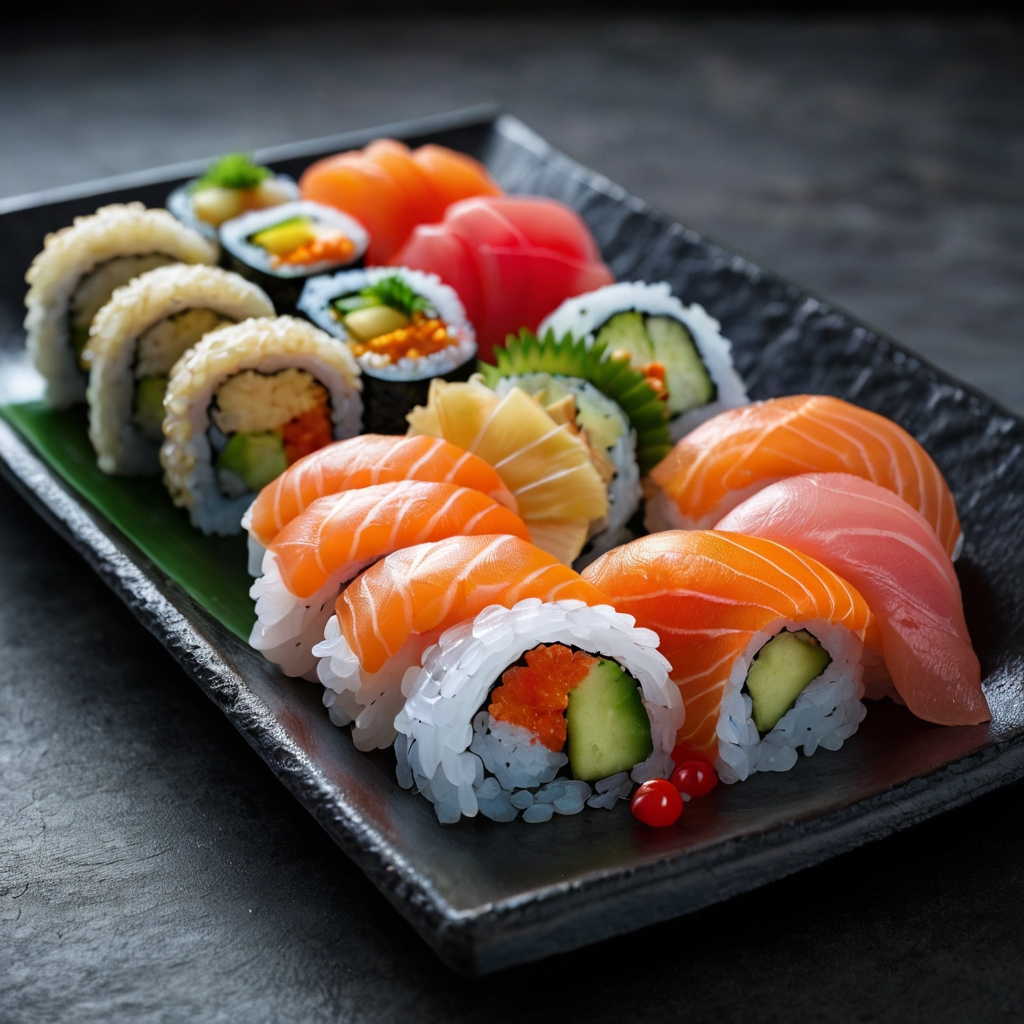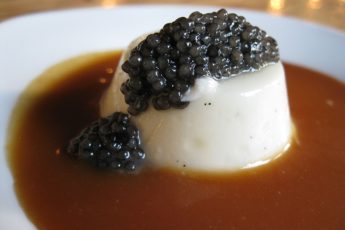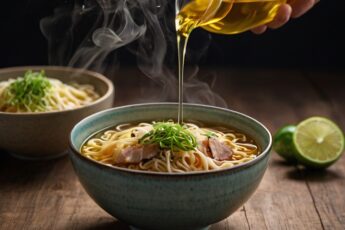Sushi vs Sashimi
Many diners confuse sushi with sashimi, two distinct Japanese culinary traditions. People often think sushi always contains raw fish, but vinegared rice (shari) defines sushi’s true essence, not the seafood.
Raw fish or seafood sliced thinly makes up sashimi, which translates to “pierced flesh” in Japanese. Sashimi comes without rice, while sushi combines vinegared rice with toppings or rolls containing fish, seafood, eggs, or vegetables. These dishes share ingredients but represent two completely different approaches to Japanese cuisine. Sashimi’s simple presentation demands masterful preparation skills, and premium fish earns the “sashimi grade” stamp. This piece explores the key differences between these popular Japanese dishes and helps you understand their unique characteristics, preparation methods, and cultural significance.

What is Sushi?
Many people think Japanese sushi is all about raw fish, but its soul lies in the carefully prepared rice. Sushi (すし, 寿司, 鮨, 鮓) represents dishes made with vinegared rice combined with various ingredients that may or may not include seafood. This traditional Japanese culinary art evolved through centuries. Modern forms came from Hanaya Yohei, who created nigiri-zushi.
The role of vinegared rice
Vinegared rice serves as the foundation of all authentic sushi. The word “sushi” means “sour-tasting” and points to the vinegar-flavored rice, not the seafood. Japanese chefs call this special rice “shari” (シャリ), “sushi-meshi” (鮨飯), or “su-meshi” (酢飯). It’s the heart of every sushi creation.
A true sushi master spends years mastering just the rice preparation. Perfect sushi rice should look polished and shiny, with grains that stay somewhat separated. The whole dish falls apart without properly prepared rice—both literally and figuratively.
Common ingredients used in sushi
The vinegared rice base pairs with ingredients that create sushi’s distinctive character:
- Seafood options: Tuna, salmon, yellowtail, eel, squid, shrimp, and imitation crab meat are common choices
- Vegetable components: Cucumber, avocado, carrots, and pickled daikon add freshness
- Wrapping materials: Nori (dried seaweed sheets) holds rolled sushi together
- Accompaniments: Pickled ginger (gari), wasabi, and soy sauce complete the experience
Sushi rice needs specific preparation. Chefs use short-grain Japanese rice or medium-grain varieties, never long-grain. They season it with rice vinegar, sugar, and salt. Some chefs add kombu (dried seaweed) during cooking to bring out umami flavors.
Is sushi always raw?
People often think sushi means raw fish. The truth is, sushi describes dishes with vinegared rice—raw seafood isn’t required.
Many authentic sushi varieties use cooked ingredients:
- Rolls with tempura shrimp
- Nigiri topped with grilled eel (unagi)
- Options featuring tamagoyaki (Japanese omelet)
Vegetarian sushi options exist without any fish or seafood. This flexibility makes sushi a match for different dietary needs.
People mix up sushi with sashimi (thinly sliced raw fish without rice). The key difference? Sushi needs rice, while sashimi is just raw fish or meat.

What is Sashimi?
Japanese culinary tradition celebrates simple elegance through sashimi. Raw fish or meat shines in its purest form in this dish. Sashimi brings its own cultural significance and preparation methods that set it apart from sushi.
Definition and meaning of sashimi
Sashimi (刺身) brings fresh raw fish or meat to your plate as thin slices. You’ll find it served with just condiments and no rice. The Japanese word translates to “pierced body”. This name comes from the ikejime process where fishers pierce the fish’s brain for quick death. The technique keeps the fish fresh by stopping lactic acid buildup.
This beautiful art form started during Japan’s Muromachi period (1336-1573). Chinese records show people ate raw sliced fish as early as 823 B.C.. Saltwater fish makes the best sashimi because it’s safer from parasites than freshwater fish. Tuna, salmon, and yellowtail are popular choices. Japanese chefs also make sashimi from beef, pork, chicken, and maybe even horse.
Sashimi’s beauty comes from its clean presentation. Perfect fish slices rest on daikon radish with just wasabi and soy sauce. The natural flavors and textures of the fish take the spotlight in this simple arrangement.
Why sashimi is not considered sushi
Sashimi has one big difference from sushi – it never comes with rice[103]. Every sushi dish needs vinegared rice, but sashimi stands alone as pure raw ingredients.
People outside Japan often mix up these terms. Each represents its own unique culinary tradition. The names tell the story – “sushi” points to vinegared rice while “sashimi” describes how chefs cut the fish.
The preparation sets these dishes apart. Sashimi demands perfect knife skills to create smooth, uniform slices that showcase the fish’s texture. Chefs cut different ingredients into various shapes – flat slices, thin strips, rectangles, cubes, or diagonal cuts.
Sashimi shows Japanese minimalism at its best. The chef’s skill lies in picking perfect ingredients and letting their natural flavors shine through minimal preparation.
Sashimi-grade fish and freshness
“Sashimi-grade” or “sushi-grade” might sound official, but these terms have no standard definition. Sellers use these labels to show the fish is safe to eat raw[122].
Fish distributors in Japan created this classification around 2004. They wanted to sell to more than just Japanese restaurants. Sellers look at bacteria levels, temperature control, parasite removal, looks, smell, taste, and harvest time.
Fresh fish makes real sashimi special. Premium fish goes through the ikejime process right after catching. A sharp spike pierces the brain before the fish goes into ice slurry. This keeps the fish fresh for about ten days by stopping extra lactic acid from forming.
The FDA guides sellers on fish safety for raw eating. Big tuna species and properly farmed salmon don’t need freezing. These fish rarely carry parasites.
The difference between sushi, sashimi, and nigiri becomes clear. Nigiri is a type of sushi with rice topped with fish. Sashimi stands alone – just the fish with no rice[103].
Sushi vs Sashimi: Key Differences Explained
The difference between sushi and sashimi explains why these culinary traditions stay distinct despite people often linking them together. These Japanese delicacies are unique in how they’re made, what goes into them, and how they look on your plate.
Rice vs no rice
The biggest difference between sushi and sashimi comes down to one thing: rice. You’ll always find vinegared rice in sushi – it’s what makes sushi what it is. Sashimi, on the other hand, is just thinly sliced raw fish or meat served by itself. This makes them two completely different types of food rather than versions of the same thing. Without rice, you can’t call it sushi – that’s sashimi. Many people think all sushi has raw fish, but the vinegar-soaked rice is what actually defines sushi.
Raw vs cooked components
There’s another key difference in how sushi and sashimi are prepared. Sashimi is always raw – usually fresh seafood like tuna, salmon, yellowtail, and sometimes other proteins. Sushi gives you many more options because it works with both raw and cooked ingredients. You’ll find authentic sushi with cooked items like tempura shrimp, grilled eel (unagi), or Japanese omelet (tamagoyaki). Sushi doesn’t even need fish – vegetarian options with cucumber, avocado, or other vegetables are just as legitimate.
Presentation and serving style
These dishes look quite different on your plate. Sashimi comes as clean, thin slices of fish or seafood, usually resting on shredded daikon radish or shiso leaves. This simple presentation lets you see the fish’s natural beauty and texture. Sushi shows up in many forms – from hand-pressed nigiri to rolled maki – each with its own special look. Sashimi pieces are usually cut thicker than the fish used in nigiri sushi to showcase the protein’s quality.
Sashimi vs nigiri vs sushi
The connection between sashimi, nigiri, and sushi becomes clear when you look at how they relate:
- Sushi is the main category that needs vinegared rice plus other ingredients
- Nigiri is a specific sushi type with hand-pressed rice topped with seafood
- Sashimi stands alone as just sliced raw fish without rice
Nigiri bridges these traditions – it uses sushi’s vinegared rice topped with fish that could be served as sashimi, but in smaller portions. Unlike regular sushi rolls, nigiri keeps it simple with just rice and topping. This knowledge helps you read Japanese menus better and appreciate the skill behind each dish.
Popular Types of Sushi and Sashimi
Japanese seafood preparations showcase an amazing spectrum of culinary artistry. The world of sushi vs sashimi teaches us about their unique preparation methods and presentation styles.
Nigiri sushi vs sashimi
Nigiri and sashimi showcase fresh seafood in two completely different ways. A piece of nigiri sushi combines hand-pressed vinegared rice with a slice of fish or seafood to create perfect harmony. Chefs sometimes add a small amount of wasabi between the rice and fish. Raw fish or seafood served without rice makes up sashimi, which usually comes with daikon radish or shiso leaves as garnish.
The main difference between these dishes comes from their basic elements. Nigiri must have sushi rice as its base, while sashimi exists purely as fish. To cite an instance, see how the same fish can create two distinct dishes – the addition of rice turns one into sushi rather than sashimi.
Maki, uramaki, and temaki
Rolled sushi varieties bring exciting textures and flavor combinations to the table:
Maki represents traditional rolls where nori (seaweed) wraps around seafood, vegetables, and rice. Chefs slice these cylinders into perfect bite-sized pieces. Japanese cuisine recognizes makimono as its original rolled sushi form.
Uramaki, known as “inside-out rolls,” switches things up by putting rice on the outside while nori hugs the fillings inside. This style became popular outside Japan and has favorites like California rolls and Philadelphia rolls that use avocado, cucumber, and cream cheese.
Temaki means “hand-rolled” and creates cone-shaped sushi where nori acts as a container for rice and fillings. Unlike other rolls, people eat temaki whole rather than sharing it in pieces.
Common sashimi varieties: tuna, salmon, scallop
Several seafood varieties stand out as customer favorites in sashimi:
Tuna (Maguro) comes in different grades and cuts. The premium selections include otoro (fatty belly), chutoro (medium-fatty), and akami (lean). Each cut offers unique textures and flavor intensities. Maguro’s dark red color makes it easy to spot on sashimi platters.
Salmon (Sake) sashimi draws attention with its bright orange color and buttery texture. Its mild, slightly sweet flavor makes it a great starting point for raw fish newcomers.
Scallop (Hotate) sashimi brings an incredibly sweet, delicate flavor with a creamy texture. Fresh scallop sashimi right from the shell captures the ocean’s natural sweetness in a way that cooked versions cannot match.
Cultural and Dining Experience
Sushi and sashimi mean more than just their taste differences in Japanese dining traditions. These dishes reflect Japan’s deep respect for quality ingredients and precise preparation.
Sushi in traditional Japanese meals
Sushi plays a unique role in Japan’s food culture. While many Western countries see it as a luxury, Japanese people enjoy sushi at various price points. Special occasions and celebrations often feature sushi. People also eat it at casual izakayas (Japanese pubs), conveyor belt restaurants, or high-end specialty spots. This wide availability shows sushi’s dual nature as everyday food and celebration cuisine.
Sashimi in kaiseki cuisine
Kaiseki ryōri, Japan’s refined multi-course dining tradition, gives sashimi a special place. These carefully planned meals include seven to fourteen courses, and sashimi appears early. The kaiseki tradition calls it “mukōzuke” and serves it before cooked dishes. Chefs pick seasonal ingredients – flounder and tuna in winter, sea bream in spring, abalone in summer, or mackerel in autumn. Each slice must be perfectly fresh and shows the chef’s expertise in selection and cutting.
How to eat sushi and sashimi respectfully
The right eating technique adds to your dining experience:
- Nigiri and rolls: You can use hands (traditional) or chopsticks
- Sashimi: Chopsticks only, never fingers
- Soy sauce: Dip the fish side down (not rice) with a light touch
- Wasabi: Keep it separate from soy sauce – chefs already add the right amount between fish and rice
- Ginger: Use it between pieces to clean your palate, not as a topping
Take one or two bites to enjoy the flavors as intended.
Pairing with sake or green tea
Green tea makes a perfect match for sushi and sashimi. It helps clean your palate between bites. The tea’s subtle bitter notes balance the fish’s rich flavors. Sake works great too, especially with salty, umami-rich dishes. Summer calls for chilled, less dry sake, while winter dishes taste better with warm, dry sake. These drinks’ natural connection with seafood brings out more umami flavors – sake’s lactic and succinic acids work particularly well with savory foods.
Summing all up
The difference between sushi and sashimi opens up a whole new world of Japanese culinary traditions. People often mix these dishes up, but they’re completely different ways to serve seafood. Sushi comes with vinegared rice as its base and shows up in many forms – nigiri, maki, and temaki. You can have it with raw or cooked ingredients. Sashimi takes a simpler path with carefully sliced premium fish served on its own.
These dishes showcase Japan’s dedication to precision, quality, and seasonal ingredients. They mean more than just food in Japanese culture. Sushi brings people together during celebrations, while sashimi plays a special role in sophisticated kaiseki dining.
Your next Japanese restaurant visit will definitely be more enjoyable with this knowledge. Try eating nigiri with your fingers – that’s the traditional way. Or take time to enjoy sashimi’s clean flavors between sips of green tea. You might even surprise your friends by pointing out what makes these culinary styles unique.
You can prefer either one – the perfect balance of rice and fish in sushi or the pure simplicity of sashimi. Both dishes are a great way to experience Japanese cultural heritage. Their worldwide popularity is proof of their exceptional quality that never goes out of style.
Here are some FAQs about sushi vs sashimi:
How does sushi differ from sashimi?
The key difference in sushi vs sashimi is that sushi always includes vinegared rice, while sashimi refers to thinly sliced raw fish or seafood served without rice. In the sashimi vs sushi comparison, sashimi focuses purely on showcasing the quality of the raw protein, whereas sushi combines fish with seasoned rice. When considering sushi vs sashimi vs nigiri, remember nigiri is a specific sushi type where fish is pressed onto rice mounds.
Is sashimi supposed to be eaten raw?
Yes, authentic sashimi is always served raw as part of the sashimi vs nigiri vs sushi distinctions. The sushi vs sashimi difference lies in preparation – sashimi highlights the pure, unadulterated flavor and texture of raw seafood. While some cooked items appear in sushi rolls, true sashimi maintains its raw state to preserve delicate flavors and textures.
Why is sashimi more than sushi?
Sashimi is often considered more premium than sushi in the sashimi vs sushi hierarchy because it showcases the highest quality cuts of fish without rice masking flavors. In the nigiri vs sashimi vs sushi comparison, sashimi requires impeccable freshness and knife skills since there’s no rice to complement or hide imperfections. Many connoisseurs view sashimi as the purest expression of seafood craftsmanship.
Is sashimi counted as sushi?
No, in the strict sushi vs sashimi vs nigiri categorization, sashimi is not considered sushi because it lacks the defining vinegared rice component. While both are Japanese seafood dishes, the sashimi vs nigiri vs sushi distinction maintains that only rice-inclusive preparations qualify as sushi. Many restaurants group them together on menus, but traditional Japanese cuisine treats them as separate items.
What’s healthier, sushi or sashimi?
In the health comparison of sushi vs sashimi, sashimi generally wins as it’s pure protein without added rice carbs or potential sauces. However, the sushi vs sashimi vs nigiri health debate depends on preparation – simple nigiri can be nearly as healthy as sashimi. Sashimi’s advantage in the sashimi vs nigiri vs sushi nutrition discussion comes from its lack of rice-based calories and potential added sugars.
Is sashimi just sliced fish?
While sashimi primarily features sliced raw fish in the sashimi vs sushi contrast, it can also include other raw seafood like octopus, scallops, or even meats like beef. The sushi vs sashimi vs nigiri distinction shows sashimi’s simplicity – it’s about perfect cuts of premium ingredients without accompaniments. However, proper sashimi presentation often includes garnishes like shiso leaves or daikon radish for visual appeal and palate cleansing.




